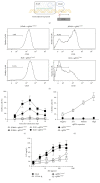A CRISPR-Based Toolbox for Studying T Cell Signal Transduction
- PMID: 27057542
- PMCID: PMC4753324
- DOI: 10.1155/2016/5052369
A CRISPR-Based Toolbox for Studying T Cell Signal Transduction
Abstract
CRISPR/Cas9 system is a powerful technology to perform genome editing in a variety of cell types. To facilitate the application of Cas9 in mapping T cell signaling pathways, we generated a toolbox for large-scale genetic screens in human Jurkat T cells. The toolbox has three different Jurkat cell lines expressing distinct Cas9 variants, including wild-type Cas9, dCas9-KRAB, and sunCas9. We demonstrated that the toolbox allows us to rapidly disrupt endogenous gene expression at the DNA level and to efficiently repress or activate gene expression at the transcriptional level. The toolbox, in combination with multiple currently existing genome-wide sgRNA libraries, will be useful to systematically investigate T cell signal transduction using both loss-of-function and gain-of-function genetic screens.
Figures



References
-
- Goldsmith M. A., Weiss A. Isolation and characterization of a T-lymphocyte somatic mutant with altered signal transduction by the antigen receptor. Proceedings of the National Academy of Sciences of the United States of America. 1987;84(19):6879–6883. doi: 10.1073/pnas.84.19.6879. - DOI - PMC - PubMed
-
- Williams B. L., Schreiber K. L., Zhang W., et al. Genetic evidence for differential coupling of Syk family kinases to the T-cell receptor: reconstitution studies in a ZAP-70-deficient Jurkat T-cell line. Molecular and Cellular Biology. 1998;18(3):1388–1399. doi: 10.1128/mcb.18.3.1388. - DOI - PMC - PubMed
Publication types
MeSH terms
Grants and funding
LinkOut - more resources
Full Text Sources
Other Literature Sources
Research Materials

